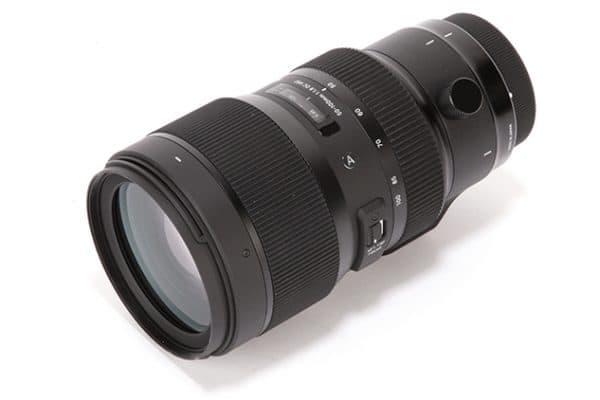Three years ago, Sigma provoked genuine excitement amongst photographers by developing the world’s first APS-C zoom with a maximum aperture of f/1.8 across its focal range. The Sigma 18-35mm f/1.8 DC HSM became a sought-after lens by those who fancied a fast wideangle to standard focal length lens at an attractive price, the only caveat with its design being that its use is strictly confined to those using APS-C sensor cameras. At the time of its release, there were suggestions that the lens might be the first in a series of fast f/1.8 zoom lenses from Sigma, but as the years rolled by it seemed like the 18-35mm f/1.8 DC HSM may have been a one off.

Not content with just the one optic in the Global Vision Art series of fast-aperture lenses, Sigma’s engineers have burnt the midnight oil and produced their second f/1.8 zoom, which was showcased for the first time at the CP+ show in Japan earlier this year. Ever since wraps first came off the Sigma 50-100mm f/1.8 DC HSM A we’ve been eagerly waiting to lay our hands on a review sample to find out how well it performs at covering the focal lengths of three popular prime lenses and whether it’s another lens APS-C DSLR users should be adding to their wish list.
Sigma 50-100mm f/1.8 DC HSM | A – Features
Firstly, it’s important to take note of the initials ‘DC’ in its name. This indicates it’s a lens that’s optimised for DSLRs with APS-C size image sensors and just like Sigma’s 18-35mm f/1.8 DC HSM cannot be used on full frame cameras without vignetting. The effective angle-of-view is equivalent to 75-150mm when it’s paired with an APS-C DSLR with a 1.5x crop factor, or 80-160mm when it’s coupled to a Canon APS-C DSLR that imposes a 1.6x multiplication. The fact it covers three popular focal lengths in one (85mm, 105mm and 135mm) makes it a highly attractive proposition for photographers who’d like to avoid carrying three prime lenses, whilst also saving the hassle of interchanging lenses on the go – a frustratingly slow process that can sometimes prevent capturing a shot at the opportune moment.

Recognised as a mid-telephoto zoom, it’s a lens that’ll see regular use in the hands of those who like to shoot portraiture and document events such as weddings, but its large aperture also makes it a great candidate for other subjects and environments such as sports, or low-light scenes where a couple of extra stops can be beneficial. It should also be noted that it’s a parfocal lens, meaning that once focus is acquired, the lens maintains that focus at all focal lengths – a particularly useful feature for video and filmmakers.
The construction of the lens features 21 glass elements arranged in 15 groups and to help minimise axial and transverse chromatic aberration, three of these elements are the ‘F’ low-dispersion (FLD) type, one is the special low dispersion (SLD) variety and there are a further three high-refractive index SLD glass elements. With such a complex arrangement of glass, it’ll come as no surprise that what we’re looking at is a fairly heavy lens and at 1,490g it works out only 50g lighter than Nikon’s AF-S NIKKOR 70-200mm f/2.8G ED VR II telephoto zoom.

Like many of the Sigma lenses we’ve reviewed of late, the lens flaunts a nine-blade aperture to create attractive blur in the out-of-focus areas of the image and features Sigma’s Hyper Sonic Motor (HSM), which in addition to driving the autofocus system offers full-time manual focusing; allowing users to adjust the focus manually at any time without having to flick the AF/MF switch to manual first. The only difference to the HSM motor is that the size of some of the components have reduced, resulting in the motor being 30% slimmer than before.
The diameter of the diaphragm is the second largest in the Sigma lens line-up after that of the monstrous Sigma 200-500mm f/2.8 EX DG. To ensure the diaphragm operates as smoothly as possible, the diaphragm blades are constructed from a carbon feather film, with the rest of the unit being made from a new polycarbonate material that’s claimed to be exceptionally durable and wear resistant. As has become standard practice on Sigma lenses, the lens employs Super Multi-Layer Coatings to prevent flare and ghosting from presenting problems when shooting towards the light. Other features include a minimum focusing distance of 95cm and it’s available in Canon, Nikon and Sigma mounts, accepting filters and adapters via an 82mm thread at the front.

The lens is presented in a soft case to offer extra protection when it’s stored or being transported, and as well as a rear cap and a sizeable front lens cap, a large plastic petal-shaped lens hood is supplied, which is finished in two-tone black and attaches securely to the front with a simple 90° twist.
Sigma 50-100mm f/1.8 DC HSM | A – Build and handling
To get a good impression of how the lens handles with different sized camera bodies, it was paired up with both the Canon EOS 80D and EOS 7D Mark II during testing. Not too dissimilar to the size and weight of a 70-200mm f/2.8 telephoto zoom, it felt better balanced coupled to the larger body of the EOS 7D Mark II, but didn’t feel uncomfortable or unwieldy with the smaller EOS 80D.

Unlike many telephoto zooms that benefit from built-in optical image stabilisation, this is one feature Sigma decided to exclude from the lens. One of the only reasons I can think of for excluding such a useful feature is to keep the asking price of the lens down and below a four-figure sum. To capture shake-free handheld shots users will find themselves cradling the lens three quarters of the way down the barrel to improve stability, but there’s always the tripod collar to turn to if you’d prefer to mount the lens to a tripod or monopod for some additional support. The size of the tripod collar plate is on the small side and doesn’t extend far below the zoom ring, meaning you can’t use it to get a secure hold of the lens like you can with more substantial tripod collars. It’s permanently attached and can’t be removed either. Loosening off the collar screw allows you to quickly switch between horizontal and vertical shooting and there are 90° click stops, which act as a useful guide when your eye is raised to the viewfinder.

The construction and overall build quality of the lens meets the high standard we’ve come to expect from Sigma’s elite range of lenses that adorn the silver ‘A’ badge on the barrel. At the rear there’s a durable metal lens mount, ahead of which you’ll find the tripod collar and large knurled screw. The diameter of the barrel widens slightly at the point you reach the zoom ring, which is encircled in rubber to provide sufficient grip when operating the lens with wet hands or gloves. It operates smoothly across its range with a quarter turn and just ahead of it are clear focal length markings at 50, 60, 70, 85 and 100mm, with a focus distance scale expressed in feet and metres. The AF/MF switch stands proud at the side of the barrel and the focus ring, which is slightly larger in diameter than the zoom ring, provides precise manual focus control through an angle of approximately 150° from the minimum focusing distance (0.95m) to infinity. It operates with what feels like just the right level of resistance and benefits from a rubber grip like the zoom ring, albeit being slightly finer grooved to make it easier to differentiate between the two from behind the camera.
Sigma 50-100mm f/1.8 DC HSM | A – Image quality
The main appeal of the lens is its fast and constant aperture, which was used to create attractive background blur and a very shallow depth of field in an array of scenes. By opening the lens to its maximum aperture (f/1.8) and carefully focusing on your chosen subject, you can create eye-catching results that draw the viewer’s eye to a person, subject or a particular area in the frame. Shifting the focus point around the frame and half depressing the shutter revealed a virtually silent autofocus operation in use and it locked on to subjects hastily and accurately without any hint of hesitation.

Test images were taken right across the lens’s f/1.8-f/16 aperture range and these were studied closely alongside our Applied Imaging tests from in the lab. The lens produces a strong set of results, and at 50mm, the sharpness in the centre improves slightly as the aperture is closed down to f/2.8, with optimum sharpness being located around f/4. Pushing towards 70mm sees the edge sharpness drop slightly at f/1.8, but centre sharpness remains high and continues to improve as the lens is stopped down to f/4.

The sweet spot between centre and corner sharpness is located closer to f/5.6-f/8 at 70mm. Sharpness in the centre and at the edges isn’t quite as high at 100mm when the lens is used wide open, but again sharpness quickly improves by stopping the aperture down by a few stops. For the sharpest results across the frame at full telephoto users will want to dial in an aperture value between f/5.6 and f/8. For those who’d like to create a larger depth of field, f/11 is usable, however the introduction of diffraction at f/16 does see the level of sharpness decline.

Users of the lens can expect the lens to exhibit some vignetting when it’s used wide open at the widest end of the focal length, however it quickly starts to disappear when the lens is closed down to f/2.8. It’s a similar story at longer focal lengths with the corners of images appearing approximately 0.8EV-1EV darker than at the centre at f/1.8. Stopping the lens down to f/2 sees an improvement and by f/2.8 vignetting clears up almost completely.

An examination of images taken of our distortion chart at 50mm, 70mm and 100mm shows that there’s negligible barrel distortion at the wide end of the focal length that gradually converts to pincushion distortion as you advance through the zoom range. The degree of curvilinear distortion is far from severe, and much like the vignetting, isn’t immediately obvious in real world images until you enable lens corrections and compare the corrected version to the original. Users will find lens profile support available in Lightroom CC 2015.5, Lightroom 6.5.1 and the latest version of Camera Raw 9.5.
Resolution

The graph tells us the lens is at its sharpest in the centre at 70mm, with corner sharpness improving as the aperture is stopped down to f/5.6. Centre sharpness isn’t quite as high at the wide and telephoto ends of the zoom, but you’ll notice from the dotted lines that the corner sharpness is better at 50mm than it is at 100mm. Optimum sharpness at the wide end of the zoom is found between f/4 and f/5.6, whereas at 70mm and beyond it’s located at f/5.6-f/8.
Shading

50mm @ f/1.8

50mm @ f/2

50mm @ f/2.8

70mm @ f/1.8

70mm @ f/2

70mm @ f/2.8

100mm @ f/1.8

100mm @ f/2

100mm @ f/2.8
The lens displays most vignetting at 100mm, however it’s not severe and is quickly dealt with by stopping the lens down to f/2.8. It’s much of a similar story at the widest end of the zoom, with the corners appearing approximately 0.7EV darker than at the centre of the image. Again, stopping the lens down to f/2 sees an improvement and by f/2.8 all trace of vignetting disappears and is no longer recognisable in real-world images. Overall, the lens handles corner shading very well.
Curvilinear distortion

50mm: SMIA TV = -0.5%

70mm: SMIA TV = 0.6%

100mm: SMIA TV = 1.2%
Shooting at the wide end of the zoom does introduce some barrel distortion, which switches to pincushion distortion at around the 70mm mark. The level of distortion isn’t a cause for concern. You’ll struggle to notice it in real-world images unless you apply lens corrections in software and then compare the corrected version to the original.
Sigma 50-100mm f/1.8 DC HSM | A – Our verdict
The appeal of the Sigma 50-100mm f/1.8 DC HSM A might be limited to those using APS-C cameras, but this doesn’t take anything away from what is an outstanding lens that delivers stunning images right across its zoom range. If you’re like me and want to create attractive background blur behind subjects at mid telephoto lengths without having to change lens and lugging around two or three fast primes, you’ll fall in love with this lens and quickly get addicted to using it at its maximum aperture.

Creating a fast lens covering all of the most popular portrait shooting focal lengths in one always had the recipe for success, but it has plenty more uses besides portraiture and Sigma still had to execute the design well and deliver first-class image quality to make it triumphant. Despite being relatively compact, it’s not a light lens and has a tendency to make smaller APS-C models feel rather front heavy. That said, the overall build quality and operation couldn’t be faulted. Real-world images reveal it produces excellent sharpness from f/1.8 to narrower apertures across its zoom range and Sigma’s engineers have paid close attention to ensuring vignetting, distortion and chromatic aberrations are controlled well.

Full frame users certainly have reason to be jealous of this lens and its arrival couldn’t be better timed either, following up on the recent releases of the Nikon D500 and Canon EOS 80D. The lens complements the also excellent 18-35mm f/1.8 in the manufacturer’s range of APS-C format zooms and is fittingly priced at under £1,000. If you own an APS-C DSLR and are considering an 85mm, 105mm or 135mm telephoto prime, this zoom must be added to your ‘lenses to consider’ list.








